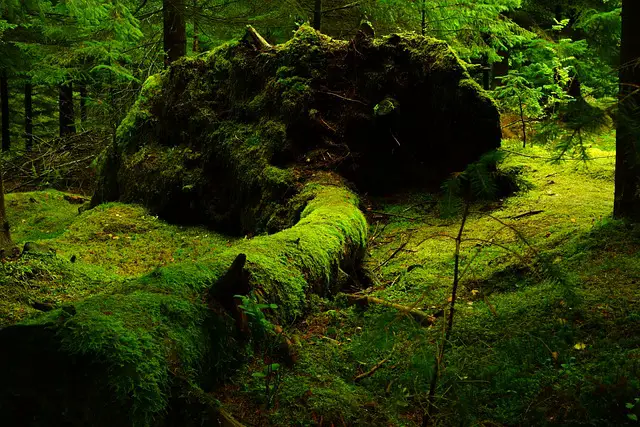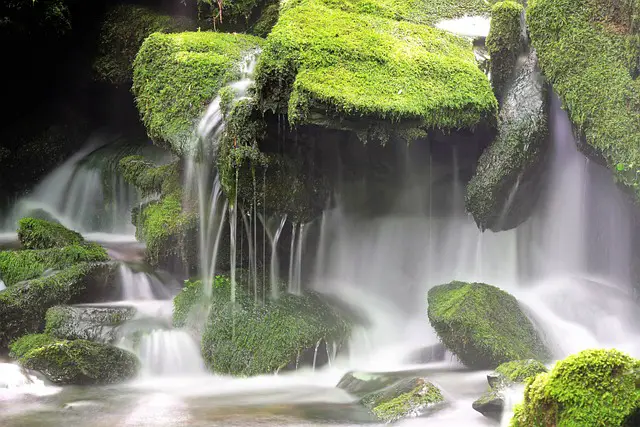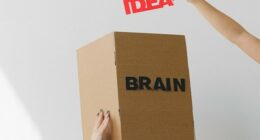Ferns are vascular plants that have leaves, stems, and roots, and reproduce by spores. Mosses, on the other hand, are non-vascular plants that lack roots, stems, and leaves, and reproduce by spores.
What are ferns?
(Photo by Robert Nelson on Unsplash )

Ferns are a type of plant that reproduce using spores. They typically have leaves that are divided into smaller leaflets, and their stems are either creeping or climbing. Ferns can be found in a wide range of habitats, including both moist and dry environments.
What are mosses?
(Image by woong hoe from Pixabay )

Mosses, are small, ground-dwelling plants that lack true roots Instead, they have rhizoids – short, root-like structures – that anchor them to the ground. Mosses reproduce using spores as well, but their leaves are usually simple and undivided. they grow close to the ground in damp areas.
There are over 12,000 species of mosses found all over the world, in a wide range of habitats including forests, deserts, and even on the pages of old books!
The difference between ferns and mosses
Ferns and mosses are both types of plants, but they have several key differences.
- Vascular vs. non-vascular: Ferns are vascular plants, which means they have specialized tissues that transport water and nutrients throughout the plant. Mosses, on the other hand, are non-vascular plants and do not have these specialized tissues.
- Roots, stems, and leaves: Ferns have true roots, stems, and leaves, while mosses do not have true roots, stems, or leaves. Instead, mosses have thread-like structures called rhizoids that anchor them to a surface.
- Reproduction: Ferns reproduce by spores, which are produced on the underside of their leaves. Mosses also reproduce by spores, but the spores are produced on specialized structures called sporangia.
- Habitat: Ferns are found in a variety of habitats, including forests, meadows, and wetlands. Mosses are often found in moist environments, such as bogs, swamps, and forests.
Overall, ferns and mosses are both unique types of plants with different structures, methods of reproduction, and habitats. While ferns have true roots, stems, and leaves, and are vascular plants, mosses lack true roots, stems, and leaves and are non-vascular.
What is the difference between fern and moss sporophyte?
Ferns and mosses are two very different types of plants. Ferns reproduce via spores, while mosses reproduce via rhizoids. Mosses have a simple life cycle, consisting of a sporophyte stage followed by a gametophyte stage. Ferns have a more complex life cycle, involving an alternation of generations between the sporophyte stage and the gametophyte stage. The main difference between ferns and mosses is their method of reproduction.
What are the differences between the moss and fern life cycles?
Moss and ferns are both plants that have simple life cycles. Both start as spores, which are tiny, lightweight cells that can be carried by the wind. When a spore lands in a moist environment, it germinates, or starts to grow.
The moss life cycle starts with a spore germinating into a protonema, which is a thread-like structure. The protonema then produces leaves and stems, and finally produces sporophytes – the plant’s reproductive structures. The sporophytes produce spores, which start the cycle over again.
The fern life cycle is similar to the moss life cycle in that it also starts with a spore germinating into a protonema. However, instead of producing leaves and stems, the protonema of a fern produces fronds – the leaf-like structures of ferns. Ferns also produce sporophytes, which produce spores that start the cycle over again.
Which characteristics are common between moss and fern?
Mosses and ferns are both types of plants that share some common characteristics:
- Reproduction by spores: Both mosses and ferns reproduce by producing spores that are dispersed by the wind. The spores develop into new individuals under favorable conditions.
- Lack of flowers and seeds: Neither mosses nor ferns produce flowers or seeds for reproduction. Instead, they rely on spores to produce new individuals.
- Lack of true roots: While both mosses and ferns have structures that anchor them to a surface, neither has true roots like modern plants. Instead, they have thread-like structures called rhizoids that help them absorb water and nutrients from the soil.
- Adaptation to moist environments: Both mosses and ferns are adapted to moist environments, and are often found in damp or shaded habitats such as forests, wetlands, and bogs.
Overall, mosses and ferns are both ancient types of plants that share some common features, including spore-based reproduction, lack of flowers and seeds, absence of true roots, and adaptation to moist environments.
Do ferns have roots?
Ferns have roots, but moss does not. Ferns are vascular plants, which means they have a system of tubes that transport water and nutrients throughout the plant. Mosses are nonvascular plants, which means they do not have these tubes. Instead, mosses absorb water and nutrients through their leaves.
How do ferns and moss reproduce?
Ferns and moss reproduce by spores. Mosses release their spores into the air, where they are caught by the wind and carried to new locations. Ferns often have special structures on their leaves, called sporangia, that protect the developing spores. When the sporangia mature, they open and release the spores. The spores then land on moist ground and begin to grow into new plants.
Is moss a bacteria or fungus?
Moss is neither a bacteria nor a fungus. Moss is a type of plant that belongs to the division Bryophyta, which also includes liverworts and hornworts. Mosses are non-vascular plants that lack true roots, stems, and leaves. Instead, they have thread-like structures called rhizoids that anchor them to a surface and help them absorb water and nutrients from the soil. Mosses reproduce by spores, which are produced on specialized structures called sporangia.
Is fern and moss good for the garden?
Both ferns and mosses can be beneficial for gardens in certain ways.
Ferns are a popular choice for shade gardens as they can thrive in low-light environments and add a lush, tropical feel to the landscape. Many fern species are also relatively low-maintenance, making them a good choice for gardeners who want to add greenery to their yard without a lot of fuss.
Mosses can also be used in gardens, particularly in areas where other plants struggle to grow. Moss can provide an attractive ground cover in shady or damp areas, and can help prevent soil erosion. Some gardeners also use moss to create moss gardens, which are designed to showcase the unique textures and colors of different moss species.
However, it’s worth noting that moss can sometimes be considered a weed in lawns, and can be difficult to control if it spreads beyond where it’s wanted. Additionally, some ferns and mosses may be invasive in certain areas, so it’s important to choose species that are well-suited to your climate and location.
What are the benefits and drawbacks of ferns and mosses?
Ferns and mosses are both unique types of plants with some benefits and drawbacks.
Benefits of ferns:
- Ferns are often grown for their attractive foliage, which can add color and texture to a garden.
- Many fern species are relatively low-maintenance and can thrive in low-light or moist environments.
- Ferns are non-invasive and can be grown in containers, making them a good choice for small gardens or indoor spaces.
Drawbacks of ferns:
- Some fern species can be aggressive and may spread beyond where they’re planted, becoming invasive.
- Ferns can be vulnerable to pests and diseases, which can damage or kill the plant.
- Some fern species require specific growing conditions and may be difficult to grow in certain areas or climates.
Benefits of mosses:
- Mosses can be used as a ground cover in areas where other plants struggle to grow.
- Mosses can help prevent soil erosion and can provide a natural look to a landscape.
- Mosses require little maintenance and can tolerate a wide range of growing conditions.
Drawbacks of mosses:
- Some species of mosses can be invasive and may spread quickly, taking over other plants or areas of a garden.
- Mosses can be difficult to control if they spread beyond where they’re wanted.
- Mosses may not be well-suited for areas that receive a lot of foot traffic or heavy use, as they can become compacted and damaged.
Overall, ferns and mosses can provide unique benefits to a garden or landscape, but it’s important to choose species that are well-suited to your specific location and growing conditions. Additionally, it’s important to monitor these plants to prevent them from becoming invasive or taking over other areas of the garden.
Featured Image By – Image by Jaesung An from Pixabay









